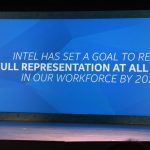How These Companies Achieved Parity Without Diversity Initiatives
Some of the world’s largest banks and insurance providers just signed a pledge aimed at getting more women into leadership at their organizations. The likes of Barclays, HSBC, Deutche Bank, and Morgan Stanley, among other firms, agreed to set goals to diversify their upper management and report on their progress annually. Failure to meet the goals will be tied to the bonuses of their senior executive teams. According to Catalyst, women make up nearly half of all employees in the financial services industry, but only 25% of senior management roles.
The 50/50 Board
“It’s good to have a goal,” Mindy Grossman tells Fast Company. But the CEO of interactive multichannel retailer HSN, Inc. (you probably know it as the Home Shopping Network) says, “A mandate can create a falseness,” as opposed to working toward achieving diversity as sound business decision. Grossman, who says her passion for diversity extends back more than 15 years to her tenure as global VP at Nike, believes that the more voices and minds you bring to the table the greater the degree of problem solving and innovation you can have. “I’m also talking about a diversity of thought and experience,” she points out, not just of gender and race.
Under her direction since 2006, HSN has made gains in both market share and diversity. Revenues have been on the rise since 2011, going from $3.18 billion then to 3.6 billion in 2015. Currently, she presides over a staff that boasts 61% female representation at the director level and above. Forty-five percent of HSN’s vice presidents and 50% of its executives are women. “What’s happened here is the fundamental foundation of who we are,” she maintains, “We are naturally diverse as an organization.
With last week’s appointment of Fiona Dias to HSN’s board of directors, the company achieved gender parity there, too. But Grossman insists this wasn’t about driving toward a percentage, but creating the best board for the company. A company that, she underscores, has a customer base who is 85% female.
Grossman says that she’s been looking at the board composition for the past number of years not only through a gender lens, but also through one of competency. Having experience relevant to the e-commerce business was necessary, but she wanted to bring in another woman. It’s a challenge because currently, women only hold 19.2% of S&P 500 board seats in the United States, according to Catalyst.
“What I am finding is that you really have to be much more aggressive to stick to the fact that this is what you want,” she explains. “I’ve seen too many instances where a board makes a profile so narrow,” she recalls, that it turns into a pipeline problem. If you are looking for a female CEO of a Fortune 500 company, for example, how many are out there? ( Only 20)
To find the right person, Grossman says they worked with a consultant who has partnered with a lot of companies in the tech world. They looked for relevant experience, she asserts, but “we definitely had a focus.” The result, she contends is that the combination of personalities and insights creates a more stimulating dialogue. “That’s more thought provoking for management,” she adds.
Getting Generational Parity
As Grossman points out, diversity isn’t just about race and gender. Generational differences can create a similar chorus of disparate points of view.
At Everbridge, a global software company that helps government agencies and businesses warn people about severe weather, mass shootings, and cyber attacks, they’ve achieved a workforce split of 44% millennials, 44% Gen Xers, and 12% boomers.
The Massachusetts-based firm observed media coverage of the age bias heavily present in tech companies in Silicon Valley. But Everbridge’s CMO, Joel Rosen, tells Fast Company, “Fortunately, our team did not need to make any concerted effort to equalize any generational splits.”
He insists it’s been an organic occurrence that came as a result of the company’s culture. “Our focus on transparency, accountability, and opportunity, as well as our ability to “make a difference” in the lives of the communities and businesses that we serve,” Rosen says, “naturally appeals across generations.”
The staff has regular access to all Everbridge’s financial results and quantitative goals. On the HR side, says Rosen, core competencies and success metrics are established each year, and teams are given internal training, education resources, mentors and benefits. “This focus on providing clear direction and objectives appeals to both younger and older workers,” he says.
Everbridge’s workforce grew by 50% this year, but eliminates bias by hiring through a behavioral interview process. “This technique was adopted to improve our ability to assess candidates and to further focus on identifying candidates that have the competencies that we believe make an individual successful at Everbridge,” Rosen explains. Competencies include adaptability, collaboration skills, resourcefulness, and passion or drive.
For example, he says that when assessing someone’s passion you could ask the question: “Tell me about a time you set a really ambitious goal for yourself. What was the goal, how did you go about achieving the goal, and what was the outcome?” Rosen contends this question doesn’t factor in age or experience.
The company credits its generationally diverse staff as one of the reasons its revenue is over $50 million.
Hiring Toward Parity
Jellyvision, an interactive software company, has just over 300 employees. Though they haven’t tracked progress over time, the workforce in total is currently made up of 51% males and 49% females and their leadership team is 55% male and 45% female.
Mary Beth Wynn, the vice president of people at Jellyvision, says getting close to gender parity wasn’t a direct initiative as much as a byproduct of the company’s values, leadership, and an intentional recruitment process.
Wynn also acknowledges that diverse staff can help the business succeed, and says Jellyvision is continually working to achieve diversity in as many aspects as possible, whether it be through gender, sexuality, race, etc.
If Jellyvision had made 50/50 a conscious initiative, though, they would have risked the reverse. Deserving individuals might not have the opportunity for a role because their gender wouldn’t fit the company’s goal. Wynn says they do work with recruiters who are directed to bring them diverse candidates.
For their job postings, Wynn says, “We lead with the characteristics that we’re looking for and leave “requirements” to the end of the posting.” She says this serves not to knock out candidates with requirements, but rather “give them a well-rounded perspective on what the job is and what characteristics we’re looking for.” The hope, she says, is that applicants will self-select based on those rather than a degree or years of experience.
Jellyvision’s hiring team really pays special attention to cover letters. “We give folks the opportunity to tell us why they’re a fit, which may highlight things we won’t see in a resume,” she explains.
All candidates must also pass through an audition, which is a skills test for people to show what they can do, rather than count on their background and previous experience alone. Wynn says, “We make the ‘audition’ part of our hiring process identity redacted to avoid any subconscious bias that might be associated with a name.”
Wynn also notes that the company’s FAQ page addresses questions around transgender and disabled candidates and their needs. “This supports our position on welcoming individuals of all backgrounds.”
Wynn notes that Jellyvision is still small enough for senior leadership to see who’s accomplishing what. “We move people into leadership positions based on what we’re seeing,” she says, which also occurs organically rather than through mandates.
Parity As A Business Imperative
Grossman underscores that there is still much work to be done. “Given the disparity, we are not going to get where we need to go if senior leaders don’t embrace this as a business imperative.”
Copious amounts of research have indicated that diversity quantitatively and qualitatively improves business performance. A recent study revealed that an even gender split at one company contributed to a 41% increase in revenue. Catalyst found that companies with higher female representation in top management outperform those that don’t by delivering 34% greater returns to shareholders. Although only 5% of Fortune 1000 companies have a female CEO, they generate 7% of the Fortune 1000’s total revenue and outperform the S&P 500 index during the course of their respective tenures. “If you are not diverse,” says Grossman, “you are saying: ‘I don’t want to be successful.’”
CORRECTION: A previous version of this article stated that their revenue was approaching $100 million. The company has since revised that estimate and tell Fast Company that their revenue is over $50 million.
Fast Company , Read Full Story
(23)













